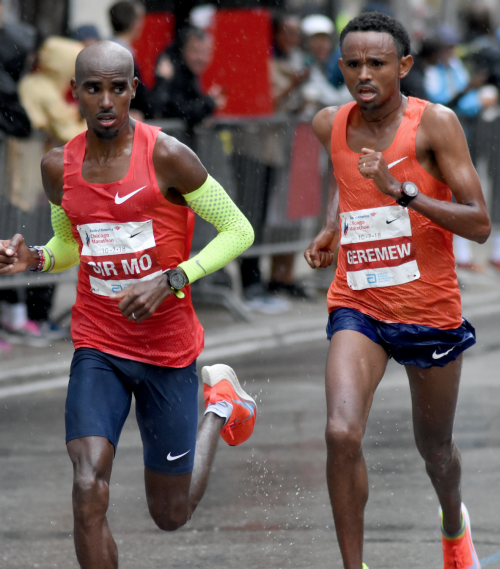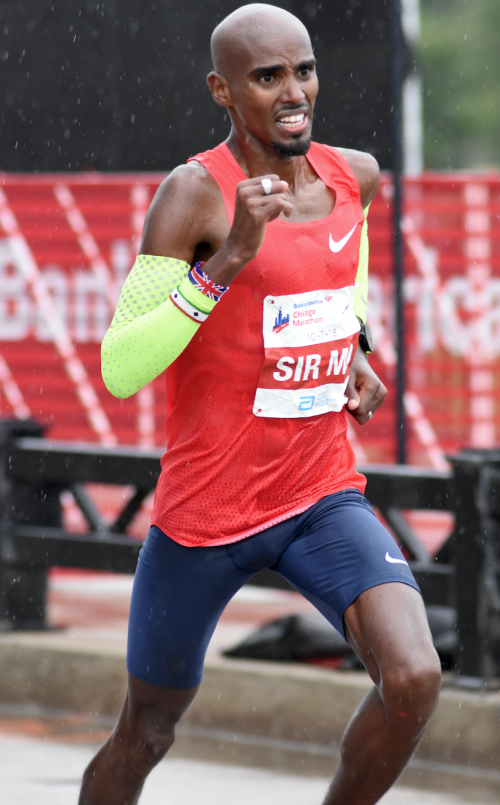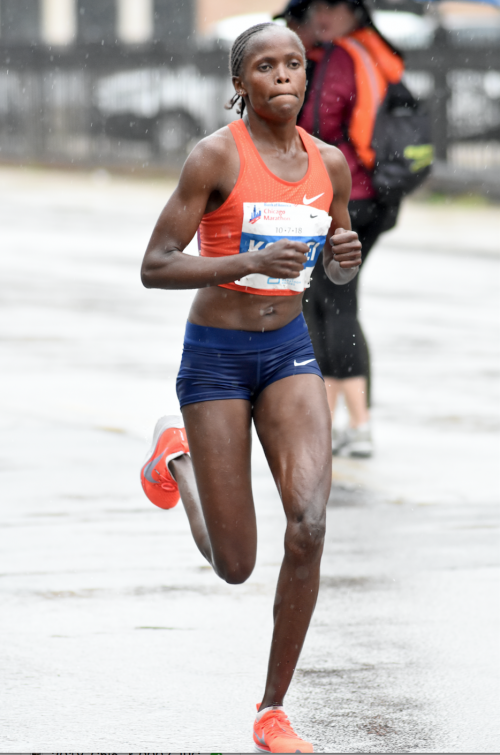 Mo Farah and Mosinet Gebremew, the upcoming battle, photo by Sean Hartnett/ The Bank of America Chicago Marathon
Mo Farah and Mosinet Gebremew, the upcoming battle, photo by Sean Hartnett/ The Bank of America Chicago Marathon
In a major marathon, there is a point when the alpha athlete, well, the most alpha athlete of the race, smells the weakness and begins to put in the proverbial screws, the race comes to its climax. That Mo Farah did not know who Gebremew was is a statement of fact. That Mo Farah, one of the two most alpha athletes in the marathon, lives for that moment, may be open to conjecture. None the less, Mo Farah won his first marathon and Gary Lough, his coach, showed his worth.
This is Justin Lagat’s fine piece on the race, done in front of terrrestial TV in Kenya.
Sir Mo Farah extends his reign to the roads at the 2018 Chicago Marathon
Despite the tough weather conditions in Chicago, Mo Farah ran a spectacular race in a time of 2:05:11 to beat one of the most competitive fields ever assembled for a marathon.
Farah remained patient for the most part of the race and only began showing his true colors after the 35km point. Ethiopia’s Mosinet Geremew was the only athlete who could manage to keep up with him past the 37km point as the two ran shoulder to shoulder until Farah suddenly broke away with about 500m to go and Geremew could not answer back.
With temperatures of about 8 degrees Celsius (47 degrees F) at the start of the race, the conditions were a little bit cold and wet. It was going to be a tough race.
Shortly after the start of the race, the pace setters seemed to be a little bit detached from the huge leading pack that seemed to be letting Mo Farah dictate the distance they were to keep from the pacers. Abel Kirui and Dickson Chumba joined the pack to the pacers around the 4km point.
At some point around the 15km point, the pace makers were so much ahead again and it was Geoffrey Kirui who broke away from the pack of 14 at the lead only to be joined again once he was with the pace makers. Anyone watching could not help but wonder how the race would have unfolded at that moment had the pace setters been done with their work. The more the huge pack kept together the more interesting it was going to be in towards the end when some interesting tactics would be brought to play.
When it started raining at the half way point, it would be interesting to guess what was going on in Geoffrey Kirui’s mind having led the Boston marathon in such conditions only to struggle in the last stages. Kirui who had appeared impatient at the early stages of the race behind the pace setters suddenly started to move slightly back into the pack as though he was wondering why the rain always seemed to come out on race day to deny him a win.
 Geoffrey Kiruri makes the pack hurt, photo by Sean Hartnett/ The Bank of America Chicago Marathon
Geoffrey Kiruri makes the pack hurt, photo by Sean Hartnett/ The Bank of America Chicago Marathon
Things got more interesting when Kenneth Kipkemoi suddenly tried to break away after the 30km mark and a single file formed behind him. Three athletes were soon remaining in the lead pack, but then the group became six again when Galen Rupp and Mo Farah re-joined them. Then Rupp began to drop back and it was Osako, Kipkemoi, Farah, Kirui and Geremew who remained in contention for the win at the front at the 35km point.
 Mo Farah takes off for the win, photo by Sean Hartnett/ The Bank of America Chicago Marathon
Mo Farah takes off for the win, photo by Sean Hartnett/ The Bank of America Chicago Marathon
It even got more interesting when Mo Farah increased the pace at around the 38km point going with Geremew and leaving Kipkemoi and Osako to battle it out for the third place. Farah sprinted away from Geremew to win the race ahead of the Ethiopian as Suguru Osako of Japan overtook Kipkemoi to finish third.
 Brigid Kosgei, photo by Sean Hartnett/The Bank of America Chicago Marathon
Brigid Kosgei, photo by Sean Hartnett/The Bank of America Chicago Marathon
Brigid Kosgei won the women’s race with a huge margin, running an historic time of 2:18:35. She was followed by Roza Dereje in 2:21:18 and Shure Demisa in 2:22:15.
Want bonus content on athletics? Support the sport of athletics! Support RunBlogRun as we cover the sport of athletics nearly 24/7, and get bonus content, please go to: https://www.patreon.com/
Author

Since 2013, Justin Lagat has written for RunBlogRun. His weekly column is called A view from Kenya. Justin writes about the world of Kenyan athletics on a weekly basis and during championships, provides us additional insights into the sport.
View all posts


















